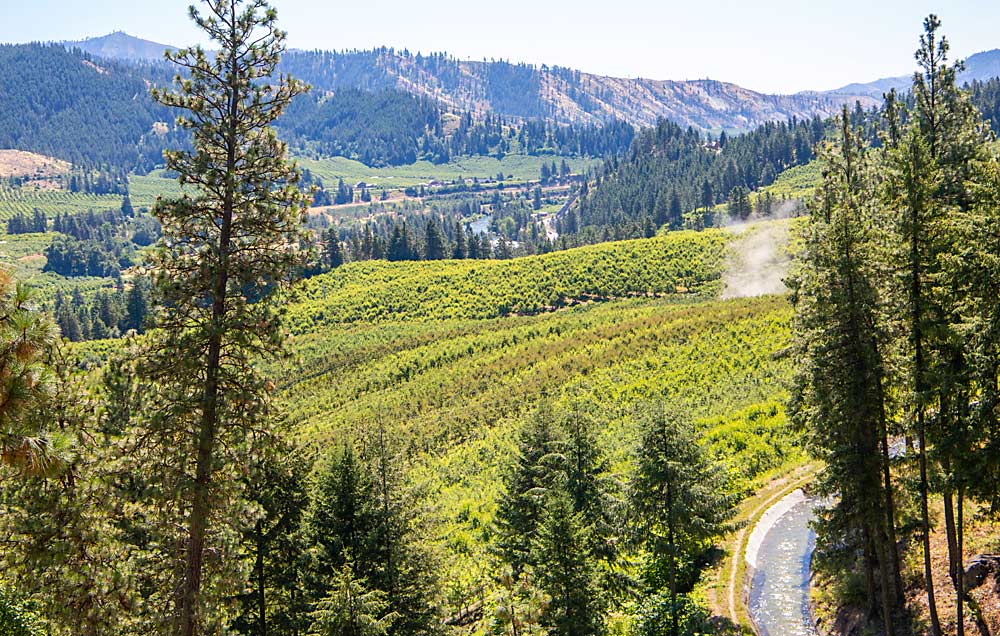
Pear day was a study of contrasts for the attendees of the International Fruit Tree Association 2022 Summer Tour through Central Washington in July.
Verdant slopes and rushing rapids of the Wenatchee River Valley versus arid bluffs overlooking the Columbia River. New plantings versus blocks that have celebrated their 100th birthday. Two-foot tree spacing and tight fruiting walls versus planting densities that would rival a public park for elbow room.
Though Northwest pear growers have their struggles — lack of dwarfing rootstocks, pest pressure and limited capital — the industry is making strides into the conversion from the freestanding trees supported by prop wood of yesteryear to high-density plantings, mimicking the efficient ways of their apple brethren.
“We’re learning we can afford to replant and get some of the old trees out, but it’s a slow process,” said Ray Schmitten, horticulturist for Blue Star Growers, a Wenatchee-area packing cooperative. “And you know pears, even with a good rootstock … we’re not getting real production until five, six, seven years.”
About the area
The Pacific Northwest grows about 17 million packed boxes of pears, more than 90 percent of the U.S. total. The Wenatchee region, the area showcased on the IFTA tour, accounts for about 40 percent of that. It’s about 75 percent Anjou, 20 percent Bartlett and 5 percent Bosc. Starkrimson, Concorde, Comice and brand new varieties such as Gem or Happi Pear hardly tip the scales.
The Wenatchee River Valley, which cuts through the foothills of the Cascade Mountains, once was home to apples and pears, but expanded irrigation access enticed the apple growers east to the flatter, windswept Columbia Basin. Pears are more winter hardy but less wind tolerant, so they stayed in the Valley, where packouts are typically higher, Schmitten said.
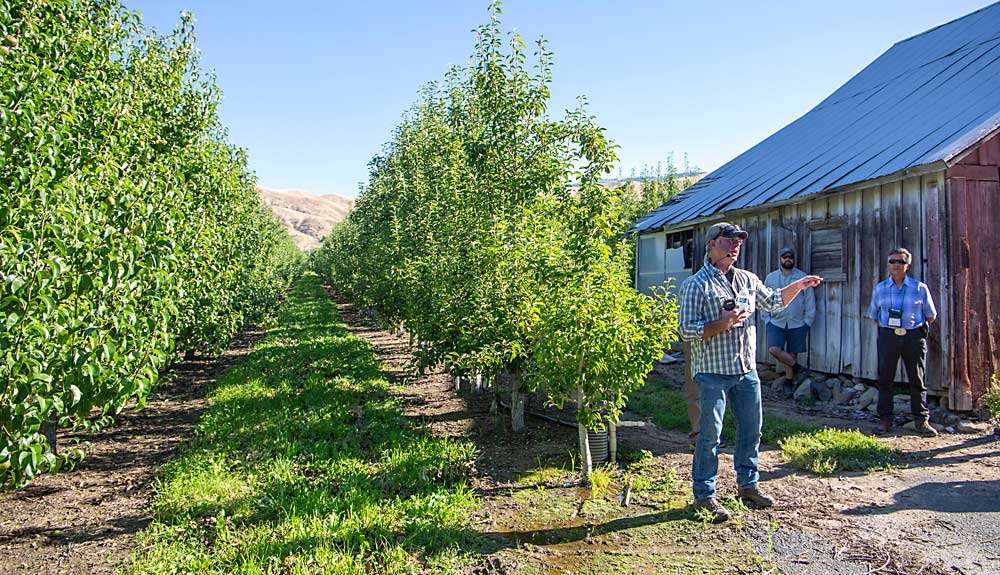
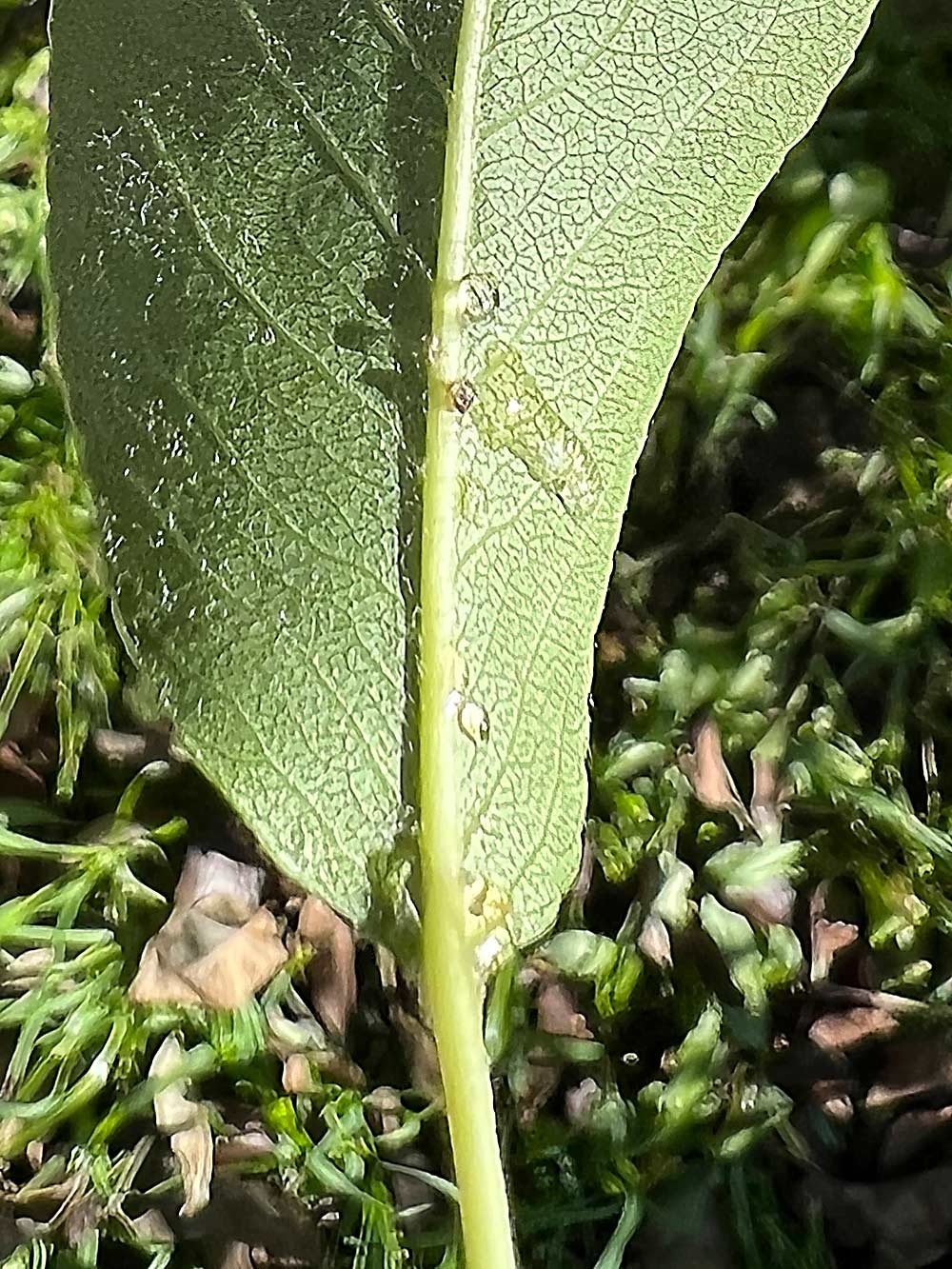
While tour-goers sweltered in triple-digit heat, Schmitten said growers in the Wenatchee Valley contend with winter injury and snow that can topple trellises, delay critical spring sprays and cause reflective sun damage to tree trunks.
The pest of concern is the pear psylla, which feeds on the bottoms of leaves and excretes sticky honeydew that marks fruit and annoys pickers. “It is just unbelievable,” Schmitten said. Protecting predators helps, as do cultural practices such as reflective fabric and kaolin clay. Many growers use overhead sprinklers to wash off the honeydew.
About 80 percent of the orchards of the river valley have 20-foot row spacing with older trees that average 35 to 50 bins per acre. Old trees challenge growers with fruit quality, namely cork, especially when drainage is bad, Schmitten said.
The tour showed a variety of approaches to increasing density, including a trellis-free approach from a small grower on a budget; a platform-managed, trellis-trained, two-leader system favored by one of the region’s largest pear producers; and a pedestrian pear planting with a density that would push the envelope for apples.
For the first stop, Schmitten showed the group a central-leader Anjou block near Cashmere, planted in 2010 on Old Home by Farmingdale 87 at 14- by 5-foot spacing. It produces about 52 bins per acre, which the company could have boosted if they planted narrower rows.
“This is one of the blocks we’ve learned from,” Schmitten said. Blue Star does not own any orchards directly but has been working with independent growers to switch to V-trellising for Bartletts and Anjous.
Density, but trellis-free
Farther up the Valley, Rudy Prey ekes as much high-density as he can from his orchard without trellises, a capital expense he does not believe he can afford. Instead, he starts his central-leader trees straight up. When they reach about 6 feet, he ties leaders to the neighboring rows to form a V-shape and an overhead archway.
He showed high-density rows of Starkrimson and Concorde, both planted 2 feet apart in 13-foot rows on OHF 97 rootstocks — chosen for their vigorous growth, which he controls through root competition from his dense plantings, summer pruning and early, heavy cropping. They both produced at least 90 bins per acre last year.
The challenge in his system is fruit maturity and coloring in the bottom portions of his trees. He’s torn: He prunes for some sun exposure and leaves a gap in the canopy above the drive row, but that just removes production in the tops of trees, where his fruit is typically better. In fact, he often removes bottom limbs as the tree grows.
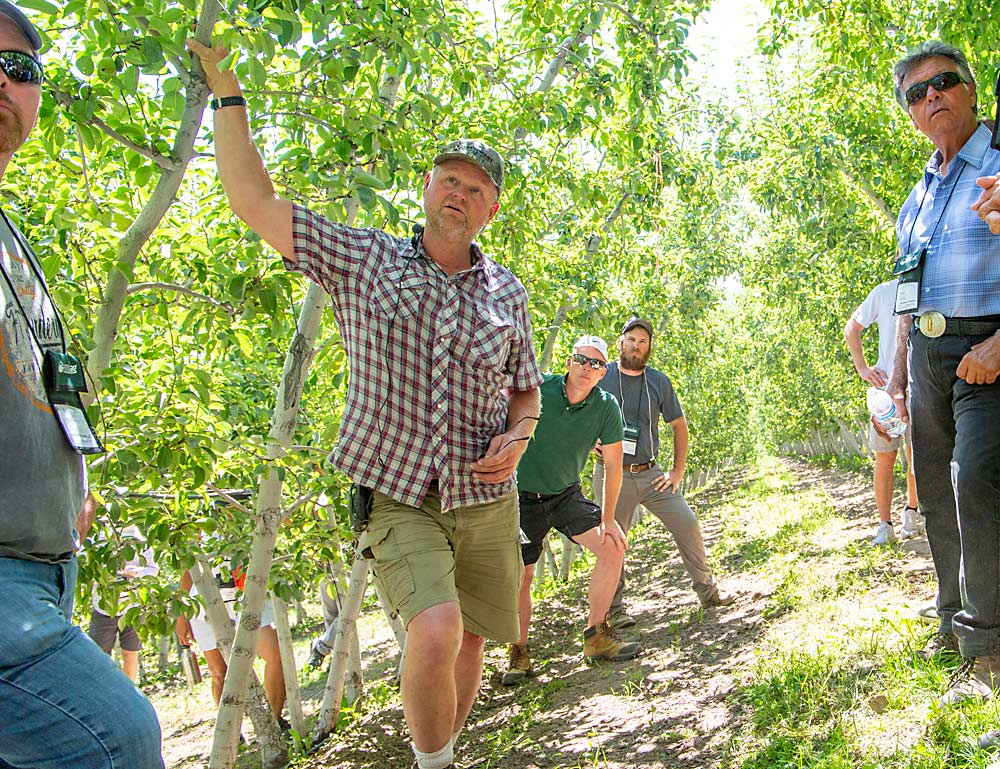
“It’s always a good idea to have a lot of fruit on the bottom,” he said. “But how much are you sacrificing on top where your better fruit is at, your better size and better quality, especially in frosty years like this year?”
One of his guiding economic principles is to remove orchards based on their five-year outlook.
“Any part of my orchard that can’t produce 60 bins per acre in the next five years, I’m going to take it out right now,” Prey said.
With his high-elevation orchard, Prey contends with bears, snow and steep slopes that make certain blocks unreachable during spray season. He has terraced a few of his blocks and is holding out for a worker platform with tracks and self-leveling.
Prey is experimenting with new varieties, such as HW 624, marketed as Happi Pear in a managed program by Stemilt Growers. He planted them at 2 feet by almost 11 feet, and he has not yet decided if he will leave them vertical or tie the leaders together like the rest of his blocks.
Tour-goers expressed curiosity about the spiral tree guards around his Happis. Available at most supply stores, they cost about $1 for each 36-inch strip. He cuts them in half and uses them to protect young tree trunks from mice and snow reflection damage.
Trellis and training
Later in the day, the IFTA group visited a Stemilt Ag Services Bartlett orchard in Entiat, surrounded by bunch grass and sagebrush. In fact, an adjacent grass fire the day before nearly disrupted the tour.
The blocks, now under organic transition, were planted in 2017 and 2018 at 6- by 12-foot spacing on OHF 97 roots and trained with two leaders into a single, vertical fruiting wall. The goal is to use platforms for pruning, thinning and harvest, said Bryan Mrachek, regional manager for Stemilt Ag Services. After trees finish filling space, the company may use mechanical hedging.
The planar training makes applications of fire blight sprays about twice as fast as for freestanding trees.
The company expects to harvest 52 bins per acre this year, shooting for 70 at full maturity next year.
The company started both blocks with a combination of click pruning, training leaders with bamboo sticks clipped to the wire, and training branches slightly above horizontal to wires with tape and string. Bending branches below horizontal risks affecting fruit size, Mrachek said.
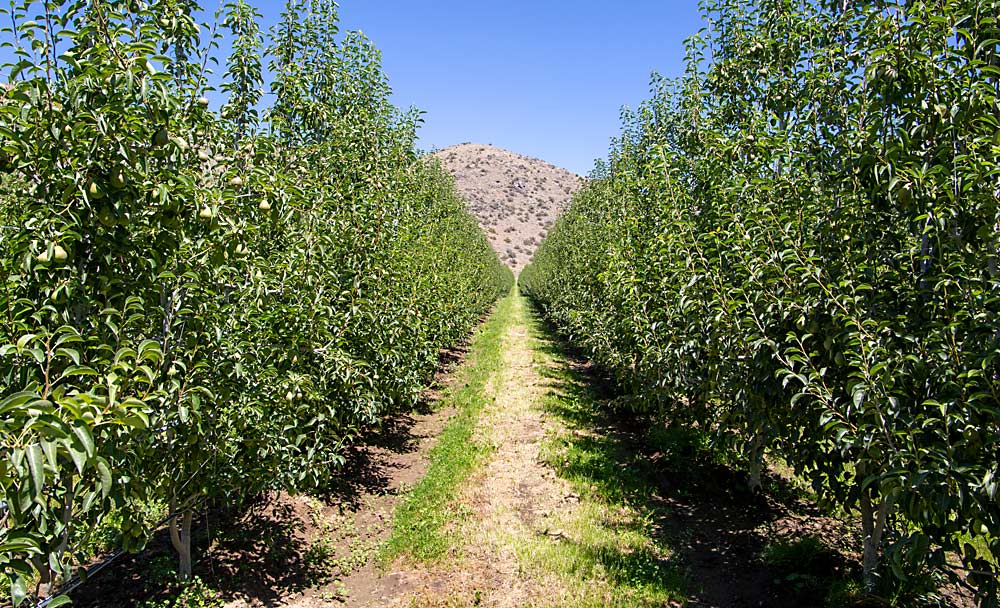
The company uses under-canopy sprinklers but leaves them on long tubes so crews can move them to the top wire for psylla washing if needed. They haven’t yet needed to, he said.
Stemilt, one of the largest fruit producers in Washington, is committed to pears, Mrachek said. The company plans to plant more pears next year and is designing a new pear packing line.
Pushing the envelope
The previous day, in the broad, flat farmland of Quincy, southeast of Wenatchee, orchardist and nursery owner Dale Goldy showed attendees an extremely high-density block of Happi Pear, the HW 624 cultivar developed by Vineland Research and Innovation Centre of Ontario, Canada.
Goldy said the cultivar’s fire blight resistance enabled him to grow pears in Quincy, with neighboring apples and row crops. His adjacent Minneiska, the apple marketed as SweeTango, also have lower fire blight risk than many apples.
He planted HW 624 in 2019 and 2020 on OHF 87 — “the smallest root we have,” he said — with a 6-foot row spacing and a 4.2-foot tree spacing.
Goldy expected the main challenge to be vigor management, and he’s been right. He has given the block almost no irrigation, but “87 is very deep-rooting,” he said, and he suspects the roots are reaching into deeper water reserves from the well-irrigated neighboring row crops.
“This is less vigor than we had last year, so we are getting on top of it,” he said. He plans to prune after the early-September harvest.
The audience asked questions about pollinizers and hedging. For pollinizers, he didn’t want to use fire-blight-prone Bosc, so he opted for a compatible, but not yet commercial variety, also from Vineland.
Matt Peters from N.M. Bartlett, the Ontario-based crop protection and equipment supplier, said that in Ontario, where the variety was first developed, growers hedge plantings in late June. Goldy said he would consider hedging once he can get a custom hedger for his 6-foot rows and figure out the best timing. •
—by Ross Courtney and Kate Prengaman

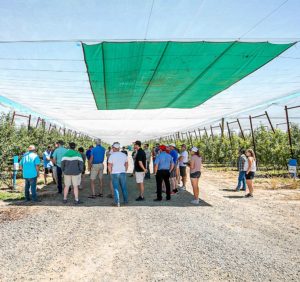
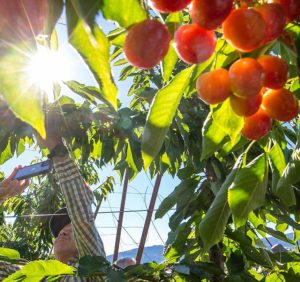
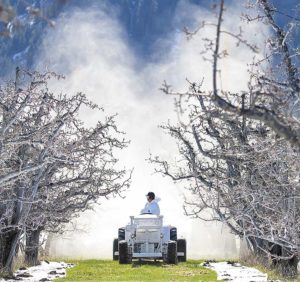
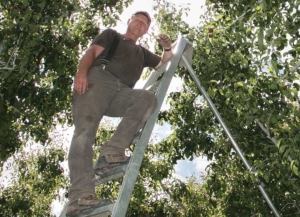
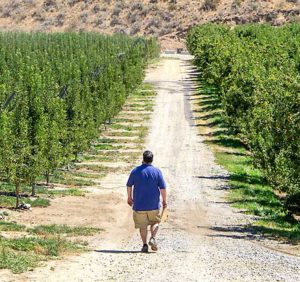
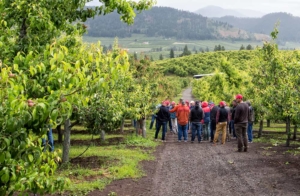





Leave A Comment